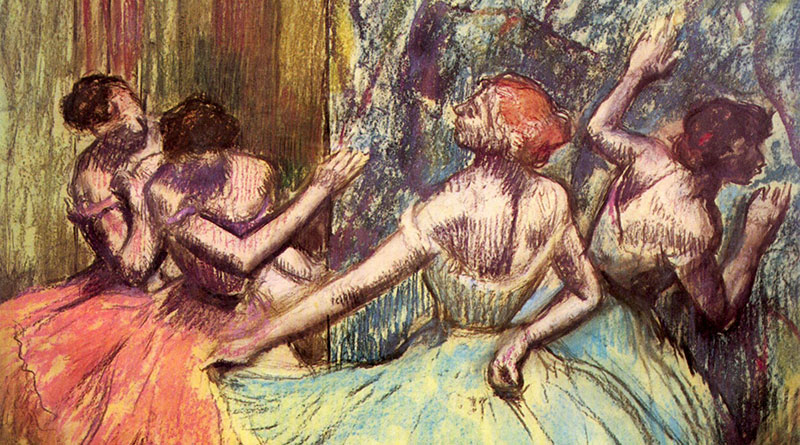
Sexual Predation in Professional Dance Culture: Biology, Politics, and Blurred Lines
Positions of power have, on occasion, inadvertently caused well-meaning people to engage in unethical behavior. Evil is not necessarily inherent; rather, more often than not, situations corrupt otherwise moral people. Human beings are tremendously fallible. We often do not live up to our highest ideals, but rather, succumb to our most base desires, or simply embody the roles that our culturally-determined social script has provided for us. Nevertheless, none of this is to say that one is not responsible for one’s voluntary actions. Regardless of what psychological tendencies our biology has predetermined on our behalf, it is our own choice to give into indoctrinated notions of what “must” be, or to acquiesce to “how things have always been done,” in an effort to quiet cognitive dissonance. In light of the personal agency we possess to control our actions, why is it that professional dancers continue to face sexual predation by superiors? What within dance culture condones, or even reinforces, such a practice?
In pondering these questions, I choose to limit myself to formalized professional Western dance genres, i.e., ballet, modern, and contemporary, whose bedrock is the hierarchical structure that places one above many, often one man above many women, with fewer people in each caste as status ascends. This dance community is uniquely distinguished from other fields in that it is largely saturated by women. Across all genres, and with few exceptions, for every male dancer, there are approximately 3 female dancers grasping for recognition in the United States.¹ One might conclude that such an environment would give rise to a matriarchal construct wherein women hold a proportionate number of leadership roles to those in the aspiring ranks. Nevertheless, this oversaturated environment exacerbates the already inherent sexism present within society at large. Despite irrefutable fact that numerous female choreographers have been able to cultivate success in the modern and contemporary dance genres, there remains a disproportionate number of men in power.
Historically, classical ballet narrative has romanticized the waifish innocent who embodies her culturally-constructed heteronormative role by giving up first her body, then often her life, for the man she loves. These antiquated gender roles portrayed in the classical ballets became reciprocally interwoven into the studio dynamic. Women were under the complete control of the ballet director, often a man who could expertly wield his power to coerce professionally dependent employees to grant sexual favors. It is not an erroneous assumption to recognize that sexuality played a considerable role in power manipulation within the studio, nor that this paradigm has persisted. Scientific research has substantiated that men are more aggressive than women, fueled by the neurotransmitter testosterone, promoting greater obsession with sexuality.² Important to emphasize, limiting this discussion to only heterosexual relationships is tremendously exclusionary; there is as much sexual predation against men as there is against women when a man is in the front of the room. Gender and sexual orientation do not eliminate the threat.
Aside from biological proclivity and gender inequality, there are certain elements of professional dance culture that lay the foundation for sexual predation to generate, namely, politics. If someone wants to exert absolute authority over a population, a historically substantiated template already exists. Autocracy is achieved when a leader instigates prejudice by pointing fingers and engaging in favoritism. In so doing, the leader is able to subjugate all; the group disintegrates into conflict as it desperately grasps for a hypothetically strong leader. Although a dance studio environment does not necessarily erupt into utter chaos, there is always, nevertheless, an underlying tension. The study of dance requires extreme ambition and motivation; there are too few jobs for those qualified. For those who have escalated to professional status, sacrifices have always accompanied the ultimate pursuit, as one is conditioned to please others rather than defend individual personal concerns. One learns to balance competition with group conformity. Discipline cultivates talent into artistry. Opportunities ignite recognition and with luck, inspire promotion. Hence, when a dancer is given attention by the person in the front of the room, it justifies past sacrifice and validates success attained in a tremendously cutthroat field. Moreover, when attention or compliment is rarely awarded, even the unsavory may be perceived as something positive. Or rather, in a field where available positions are at such a high premium, and there are so many others against whom one is competing, we dejectedly take what we can get. Depending upon the degree of liberty taken, one gauges whether fighting against the assault is professional suicide. It may become a choice between keeping one’s job, getting fired, or becoming blacklisted as “difficult,” having thwarted the advances of a superior.
Complicating the matter further, it is not always clear when sexuality is used as a means to control, rather than when it arises out of more innocuous and honest intentions. As an art form that relies upon raw vulnerability to reach its zenith, dance releases the Pandora’s Box of intimacy. Not only do dancers tend to be scantily clad physically, we bare ourselves emotionally, exposing ourselves to feelings we may not have previously considered. Lust and love are neither predictable nor wholly voluntary; nevertheless, our decision to act upon such urges are. Power and talent can be attractive, and being singled out in a competitive world is validating. Nevertheless, enabling this misogynistic paradigm to persist promulgates degrading competition. We all need to be vigilant in recognizing whether attraction is genuine, or whether the flirtation is merely a means to a subjugating end, one that does not necessarily have our personal interests, nor that of the art itself, in mind. We are all accountable: we must face the wanton reality of sexual predation and evolve, eschewing the past and creating a climate where the sex of the person in the front of the room does not automatically determine the professional success of those under his or her leadership. Preying upon professional desperation is artistic cowardice.
Calling upon a culture to evolve is daunting, but change to such a degree certainly isn’t impossible. Greater changes have taken place. I advocate that through incremental acts of individual courage, speaking up when violation takes place and not diminishing ourselves to placating tolerance, we can slowly but surely, ameliorate the situation, achieving an environment where no one falls prey to unwanted sexual advances. I make this charge knowing full well that I did not speak up when it was my turn to do so.
I was honored to be chosen as a dancer in the Famous Choreographer’s highly popular work, relishing the opportunity to dig into such a coveted, multifaceted role. Professionally, it was an undeniable highlight. Nevertheless, the evening of the premier turned sour when I realized that once again, despite my strong performance, I was simply considered yet another object to be ogled. At the after party, the Famous Choreographer sidled up to me saying that the next time he saw me, he wanted it to be without my boyfriend at my side. Later, in full view of my Artistic Director who said nothing, Famous Choreographer groped my buttocks as a farewell of sorts. I said nothing. When I commiserated in private with my fellow colleagues after the Famous Choreographer left, I was told, “oh, he’s always like that, everyone knows it,” the speaker shrugging off the incident as if it was indubitably acceptable. Of the 10 women in the company, only two escaped his inappropriate and uninvited advances. Yet still, I said nothing. I no longer possess the tolerance to remain silent.
My violations were quite slight, but many others are not. Should you find yourself in a situation that you believe is a violation of your person, take appropriate action. From a professional standpoint, you need to do what makes the most sense for you, but remember, despite variations of law from country to country, sexual assault and battery are crimes in most, if not all, of the Western World.³ If necessary, seek professional medical care immediately, and contact law enforcement. If the damage is psychological, seek counseling or a support group. Tradition is NOT paramount, and despite a lifetime of indoctrination, we should hold fast to the belief that NO ART is worth the degradation of self at the hands of another.
Moreover, the ultimate onus should not rest with the victim. What I have suggested thus far is merely a bandage to cover an already opened wound and does not address the root of the issue. First and foremost, those in power need to take responsibility for their actions, paying particular attention to not abuse their position. This is not merely common sense; it is a demonstration of basic respect for human dignity and equality. It is no longer the time for our culture to rest upon traditional paradigms of the past. The true value of art is diminished when accomplished at the degradation of others. I challenge us all to cultivate the courage necessary to uphold the integrity of our selves and our bodies, and in so doing, that of our art.
Photo: Four Dancers Behind The Scenes II by Edgar Degas
¹ In a statistical graphic depicting the “Percent of the U.S. Artists Who Are Female: 2005-2009,” provided by the International Foundation for Women Artists, 77.9% of dancers and choreographers were women. (Jihye You and Jiin Kim, “Statistics about females in the art and culture industry in U.S.: The Condition of Women Artists in the United States,” International Foundation for Women Artists BLOG, Accessed June 14, 2017, https://ifwartistsblog.wordpress.com/2014/12/08/statistics-about-female-in-the-art-and-culture-industry-in-u-s/.)
² A straightforward discussion of male aggression is found in a 2014 article written for “Psychology Today” by social ethologist Dr. Dorian Furtuna. (Dorian Furtuna, Ph.D., “Male Agggression: Why are men more violent?” Psychology Today, Accessed June 14, 2017, https://www.psychologytoday.com/blog/homo-aggressivus/201409/male-aggression.)
³ In the United States, employees are protected against sexual harassment under Title VII of the Civil Rights Act of 1964. (“Laws Enforced by the Employment Litigation Section: Title VII of the Civil Rights Act of 1964,” The United States Department of Justice, Accessed June 14, 2017, https://www.justice.gov/crt/laws-enforced-employment-litgation-section.)




Looking For Dancers to Share Their Experiences
Do you have vague feelings that something was not right with your dance training or career? Did your teacher or dance company abuse you as a dancer? Perhaps you were part of a ballet cult? For years, I couldn’t put my finger on what was wrong with my early ballet training. Not until after earning a Ph.D. and working in the field of psychology did I come to understand that I had gone through a cultic experience. I wrote an article on the topic of ballet cults and many people contacted me with their personal stories of pain, deceit, and emotional devastation. I have a publisher interested in assembling a book on this topic. I am looking for dancers who want to share their story. I will help you write your story. All information will be kept confidential. To learn more about the project, visit http://www.ChuckStewartPhD.net